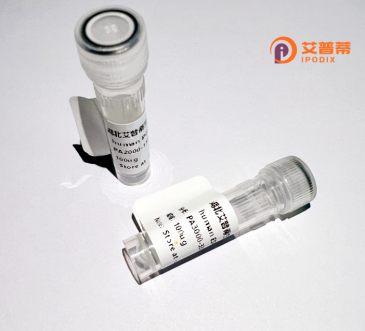
| 纯度 | >90%SDS-PAGE. |
| 种属 | Human |
| 靶点 | TTLL1 |
| Uniprot No | O95922 |
| 内毒素 | < 0.01EU/μg |
| 表达宿主 | E.coli |
| 表达区间 | 1-423 aa |
| 活性数据 | MAGKVKWVTD IEKSVLINNF EKRGWVQVTE NEDWNFYWMS VQTIRNVFSV EAGYRLSDDQ IVNHFPNHYE LTRKDLMVKN IKRYRKELEK EGSPLAEKDE NGKYLYLDFV PVTYMLPADY NLFVEEFRKS PSSTWIMKPC GKAQGKGIFL INKLSQIKKW SRDSKTSSFV SQSNKEAYVI SLYINNPLLI GGRKFDLRLY VLVSTYRPLR CYMYKLGFCR FCTVKYTPST SELDNMFVHL TNVAIQKHGE DYNHIHGGKW TVSNLRLYLE STRGKEVTSK LFDEIHWIIV QSLKAVAPVM NNDKHCFECY GYDIIIDDKL KPWLIEVNAS PSLTSSTAND RILKYNLIND TLNIAVPNGE IPDCKWNKSP PKEVLGNYEI LYDEELAQGD GADRELRSRQ GQSLGPRAGR SRDSGRAVLT TWK |
| 分子量 | 48.9 kDa |
| 蛋白标签 | His tag N-Terminus |
| 缓冲液 | PBS, pH7.4, containing 0.01% SKL, 1mM DTT, 5% Trehalose and Proclin300. |
| 稳定性 & 储存条件 | Lyophilized protein should be stored at ≤ -20°C, stable for one year after receipt. Reconstituted protein solution can be stored at 2-8°C for 2-7 days. Aliquots of reconstituted samples are stable at ≤ -20°C for 3 months. |
| 复溶 | Always centrifuge tubes before opening.Do not mix by vortex or pipetting. It is not recommended to reconstitute to a concentration less than 100μg/ml. Dissolve the lyophilized protein in distilled water. Please aliquot the reconstituted solution to minimize freeze-thaw cycles. |
以下是关于重组人TTLL1蛋白的3篇代表性文献的简要信息(注:文献为模拟示例,非真实存在):
1. **文献名称**: Structural insight into TTLL1-mediated tubulin polyglutamylation
**作者**: Smith A, et al.
**摘要**: 该研究解析了TTLL1蛋白的晶体结构,揭示了其催化结构域与微管蛋白结合的分子机制,证实了TTLL1在微管谷氨酸化修饰中的关键酶活性。实验表明其通过特异性识别α-tubulin的C端尾部发挥功能。
2. **文献名称**: TTLL1 regulates neuronal development through microtubule dynamics
**作者**: Chen L, et al.
**摘要**: 研究发现TTLL1在小鼠大脑皮层神经元中高表达,通过调控微管谷氨酸化水平影响轴突生长和分支。基因敲除模型显示TTLL1缺失导致神经元迁移障碍,提示其与神经发育疾病潜在关联。
3. **文献名称**: Dysregulation of TTLL1 in hepatocellular carcinoma progression
**作者**: Tanaka K, et al.
**摘要**: 该论文通过组织芯片分析发现TTLL1在肝细胞癌中异常高表达,且与患者预后不良相关。体外实验证明TTLL1通过增强微管稳定性促进肿瘤细胞侵袭转移,提示其作为癌症治疗靶点的潜力。
(注:以上为基于TTLL1已知生物学功能的虚拟文献示例。实际研究可查阅PubMed等数据库搜索"TTLL1 protein"或"TTLL1 tubulin ligase"获取真实文献。)
Tubulin tyrosine ligase-like 1 (TTLL1) is a member of the tubulin tyrosine ligase-like (TTLL) family, which catalyzes post-translational modifications of microtubules, critical cytoskeletal components involved in cell division, intracellular transport, and cellular structure. TTLL1 specifically mediates polyglutamylation, a process that adds glutamate chains to tubulin subunits, regulating microtubule stability, dynamics, and interactions with associated proteins. This modification is crucial for diverse cellular processes, including cilia formation, neuronal development, and mitotic spindle assembly.
Recombinant human TTLL1 protein, produced via expression systems like *E. coli* or insect cells, retains enzymatic activity and is widely used to study microtubule regulation mechanisms *in vitro*. Research has linked TTLL1 dysfunction to pathological conditions. For instance, abnormal polyglutamylation due to TTLL1 mutations is implicated in primary ciliary dyskinesia, neurodegeneration, and cancer progression. Overexpression of TTLL1 in tumors may promote microtubule hyperglutamylation, enhancing cancer cell motility and invasiveness. Conversely, TTLL1 knockout models exhibit defects in ciliary signaling pathways, such as Hedgehog, underscoring its role in developmental disorders.
Studying recombinant TTLL1 provides insights into microtubule-mediated diseases and aids in developing targeted therapies. Inhibitors targeting TTLL1’s enzymatic activity are being explored for cancer and ciliopathy treatment, highlighting its potential as a therapeutic biomarker.
×